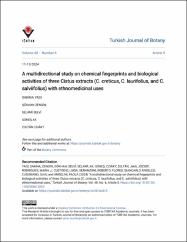| dc.contributor.author | Yagı, Sakina | |
| dc.contributor.author | Zengin, Gökhan | |
| dc.contributor.author | Selvi, Selami | |
| dc.contributor.author | Ak, Güneş | |
| dc.date.accessioned | 2024-12-02T06:46:24Z | |
| dc.date.available | 2024-12-02T06:46:24Z | |
| dc.date.issued | 2024 | en_US |
| dc.identifier.issn | 1303-6106 | |
| dc.identifier.uri | https://doi.org/10.55730/1300-008X.2820 | |
| dc.identifier.uri | https://hdl.handle.net/20.500.12462/15359 | |
| dc.description | Selvi, Selami (Balikesir Author) | en_US |
| dc.description.abstract | Humans have used medicinal plants to treat various diseases for thousands of years. Cistus species are also widely used in traditional medicine and have various medicinal applications; therefore, they deserve more in-depth research. The present study evaluated the chemical profile, antioxidant, enzyme inhibition, and cytotoxic properties of the twigs and leaves of C. creticus L., C. laurifolius L., and C. salviifolius L. grown in Türkiye. The methanolic extracts of the three species were rich in phenolics, mainly flavonoids. Exerted potent antioxidant activity with a methanolic extract from the leaves of C. salviifolius displayed the highest total phenolic (97.08-mg gallic acid equivalent/g) and flavonoid (49.60-mg rutin equivalent/g) contents, as well as antiradical (2,2-diphenyl-1-picrylhydrazyl) assay = 612.11 mg TE (trolox equivalent)/g; (2,2’-azino-bis(3-ethylbenzothiazoline-6-sulfonic acid)) = 804.66 mg TE/g), reducing ions (cupric reducing antioxidant capacity) = 690.54 mg TE/g; ferric reducing antioxidant power = 459.34 mg TE/g), and chelating (15.58 mg EDTAE/g) properties. It also revealed the best amylase and glucosidase inhibitory activity. Extracts from the twigs of the three Cistus species, except the leaves of C. salviifolius and C. laurifolius, displayed comparable acetylcholinesterase inhibitory activity (2.48–2.57 mg galanthamine equivalent (GALAE)/g). The twig of C. laurifolius also exerted the best antibutyrylcholinesterase (10.50 mg GALAE/g) and antityrosinase (73.15 mg kojic acid equivalent/g) activities. C. creticus leaves revealed toxicity toward the RAW cell line (cell viability reduced to 68.8%) and were not toxic to normal cells (S17). In conclusion, these three Cistus species were shown to be a rich source of bioactive compounds with the potential for future applications in the food, pharmaceutical, and cosmetic industries. | en_US |
| dc.language.iso | eng | en_US |
| dc.publisher | TÜBİTAK | en_US |
| dc.relation.isversionof | 10.55730/1300-008X.2820 | en_US |
| dc.rights | info:eu-repo/semantics/openAccess | en_US |
| dc.rights.uri | http://creativecommons.org/licenses/by/3.0/us/ | * |
| dc.subject | Cistus Species | en_US |
| dc.subject | Ethnomedicinal | en_US |
| dc.subject | Antioxidant | en_US |
| dc.subject | Enzyme Inhibition | en_US |
| dc.subject | Cytotoxicity | en_US |
| dc.title | A multidirectional study on chemical fingerprints and biological activities of three cistus extracts (c. creticus, c. laurifolius, and c. salviifolius) with ethnomedicinal uses | en_US |
| dc.type | article | en_US |
| dc.relation.journal | Turkish Journal of Botany | en_US |
| dc.contributor.department | Altınoluk Meslek Yüksekokulu | en_US |
| dc.contributor.authorID | 0000-0002-9959-6945 | en_US |
| dc.identifier.volume | 48 | en_US |
| dc.identifier.issue | 6 | en_US |
| dc.identifier.startpage | 321 | en_US |
| dc.identifier.endpage | 337 | en_US |
| dc.relation.publicationcategory | Makale - Uluslararası Hakemli Dergi - Kurum Öğretim Elemanı | en_US |




















